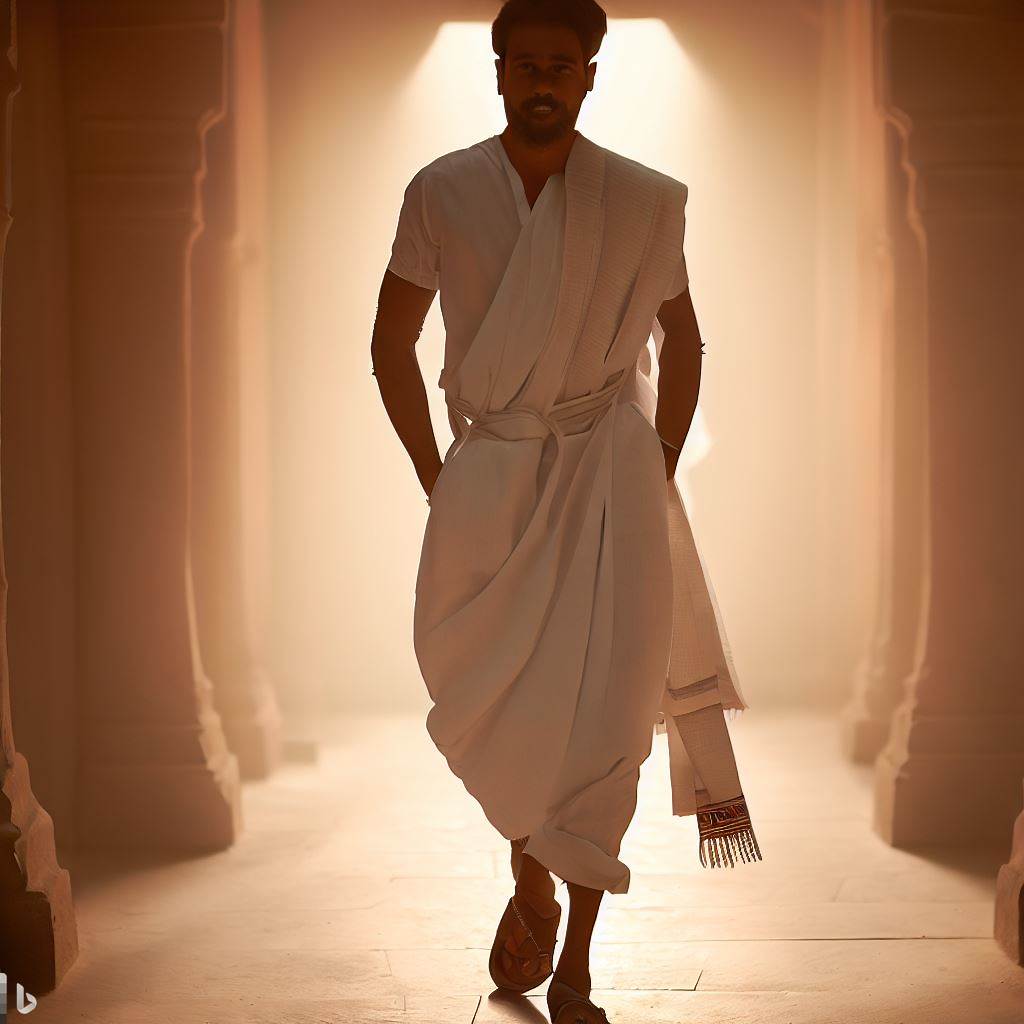In the tapestry of Indian traditional attire, the dhoti stands as a timeless emblem of elegance and versatility. Wrapped around the waist and extending down to the knees or ankles, this graceful garment holds a rich history and cultural significance dating back thousands of years. From rural villages to urban centers, the dhoti remains a symbol of India’s enduring heritage and continues to captivate both locals and global admirers alike.
Origins and Evolution: The roots of the dhoti can be traced back to ancient India, where it was a staple attire worn by men across different social strata. It is believed to have originated during the Indus Valley Civilization and has evolved over the centuries, adapting to regional variations and fashion trends. Traditionally made of cotton, the dhoti was a practical choice for India’s warm climate and served as comfortable clothing for daily activities and festive occasions.
Draping Styles: One of the distinctive aspects of the dhoti is its versatile draping styles. There are various ways to wear a dhoti, each reflecting the cultural practices of different Indian states and communities. The most common style involves wrapping the fabric around the waist and securing it with pleats, while variations may include tucking the pleats in the front or back, and the length of the cloth, depending on the occasion and personal preference.


Cultural Significance: The dhoti holds deep cultural and religious significance in India. It is an essential garment for many religious ceremonies, festivals, and rituals. In some regions, the dhoti is associated with specific rites of passage, symbolizing the transition from childhood to adulthood or signifying a special milestone in one’s life. Additionally, spiritual leaders and gurus often wear the dhoti as part of their traditional attire, exemplifying its sacred aura.
Regional Diversity: India’s vast and diverse landscape has given rise to a wide array of dhoti styles and designs. For example, in Southern India, the “veshti” or “mundu” is a popular dhoti variant, typically worn in pristine white. In contrast, Northern regions may favor the “dhoti kurta” ensemble, which pairs the dhoti with a long tunic-like top. Each variation showcases the regional aesthetics and cultural nuances, making the dhoti a testament to India’s cultural unity in diversity.
Resurgence in Contemporary Fashion: While the dhoti remains deeply rooted in tradition, it has also witnessed a resurgence in contemporary fashion. Designers and fashion enthusiasts have embraced the dhoti’s elegant simplicity and incorporated it into modern clothing collections. The dhoti has made appearances on fashion runways and red carpets, not only in India but also at international events, showcasing its adaptability and timeless appeal to a global audience.
Celebrating the Legacy: Despite the changing trends and the rise of western clothing, the dhoti continues to hold a special place in the hearts of many Indians. It serves as a proud symbol of cultural identity, evoking nostalgia for the bygone era. Several cultural events, especially traditional weddings and festive celebrations, witness a revival of dhoti as people fondly embrace their heritage and honor their ancestry.
The dhoti remains an indelible thread woven into the fabric of Indian culture, representing the timeless charm of a bygone era while effortlessly transitioning into the contemporary fashion landscape. As a versatile and enduring garment with a rich history, the dhoti stands as a reminder of India’s cultural heritage, celebrated not only within the country’s borders but also cherished and respected by admirers worldwide. Embodying grace, simplicity, and cultural significance, the dhoti continues to grace India’s diverse tapestry, leaving an enduring legacy for generations to come.

Its like you read my mind! You appear to know so much about this, like you wrote the book in it or something. I think that you can do with a few pics to drive the message home a little bit, but other than that, this is wonderful blog. A fantastic read. I will definitely be back.
Hello. impressive job. I did not expect this. This is a excellent story. Thanks!
I couldn’t have asked for an even better blog. You are there to supply excellent guidance, going instantly to the point for straightforward understanding of your readership. You’re really a terrific professional in this matter. Thanks for remaining there for people like me.
I like assembling useful information , this post has got me even more info! .
After study some of the web sites in your web site now, and i also truly like your technique for blogging. I bookmarked it to my bookmark website list and will be checking back soon. Pls have a look at my web page in addition and make me aware if you agree.
Can I simply say what a relief to get someone who actually knows what theyre speaking about online. You definitely discover how to bring a problem to light to make it important. The best way to ought to check this out and appreciate this side on the story. I cant believe youre less well-known when you undoubtedly hold the gift.
Whenever I like to find out something or desire to read some stimulating article, the web never disappoints me. I share these posts with my friends and colleagues and can start a decent exchange over various issues,
Generally I don’t read article on blogs, but I wish to say that this write-up very forced me to try and do so! Your writing style has been amazed me. Thanks, quite nice post.
Take a peek at the following tips what follows discover ideal way to follow such a mainly because you structure your small business this afternoon. earn money
I do know this isn’t precisely on subject, however i’ve a site using the identical program as properly and i get troubles with my feedback displaying. is there a setting i am missing? it’s doable chances are you’ll assist me out? thanx.
Get upset! Simply letting the quota happen isn’t acceptable. This will help you stay above the curve.